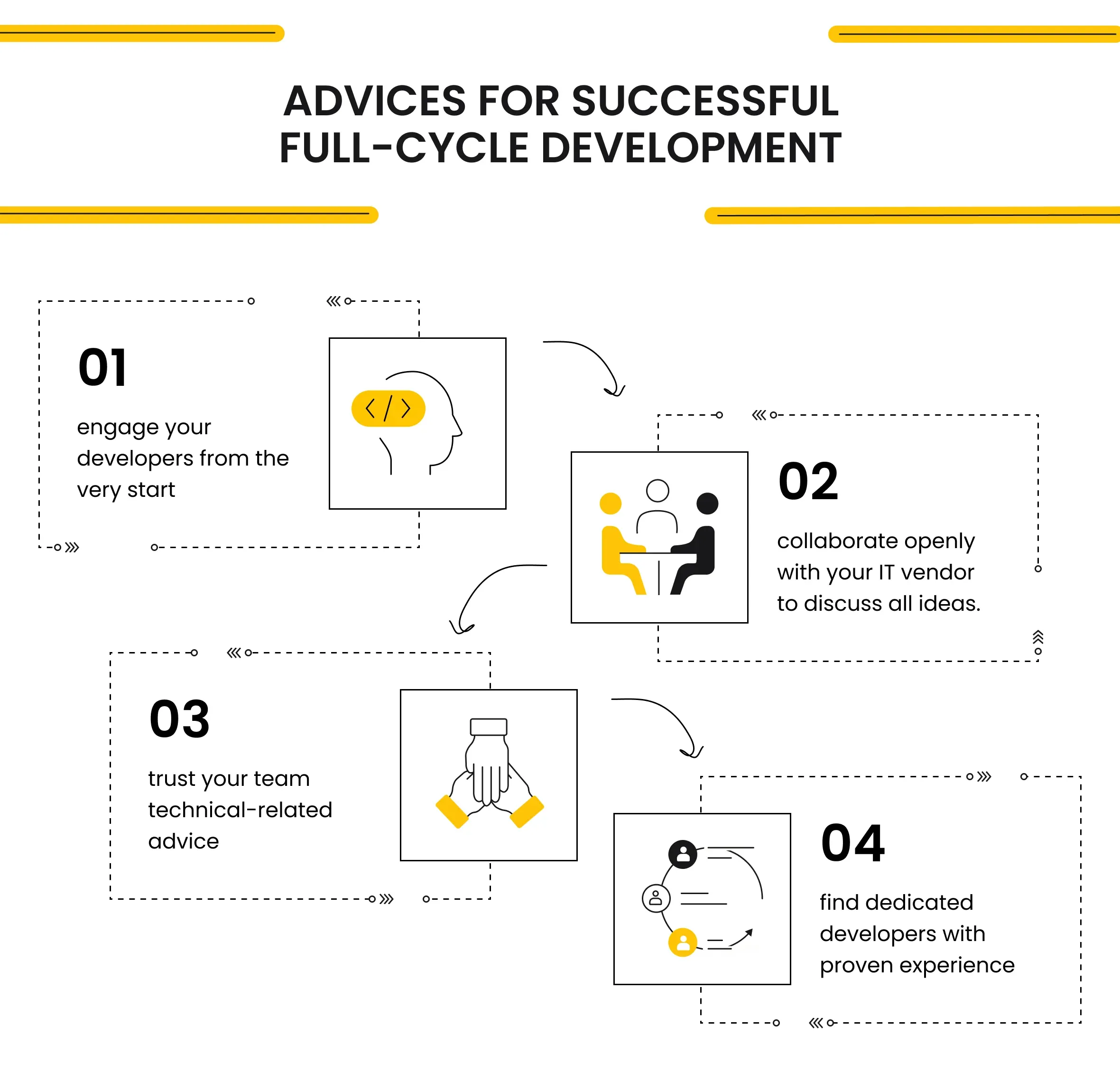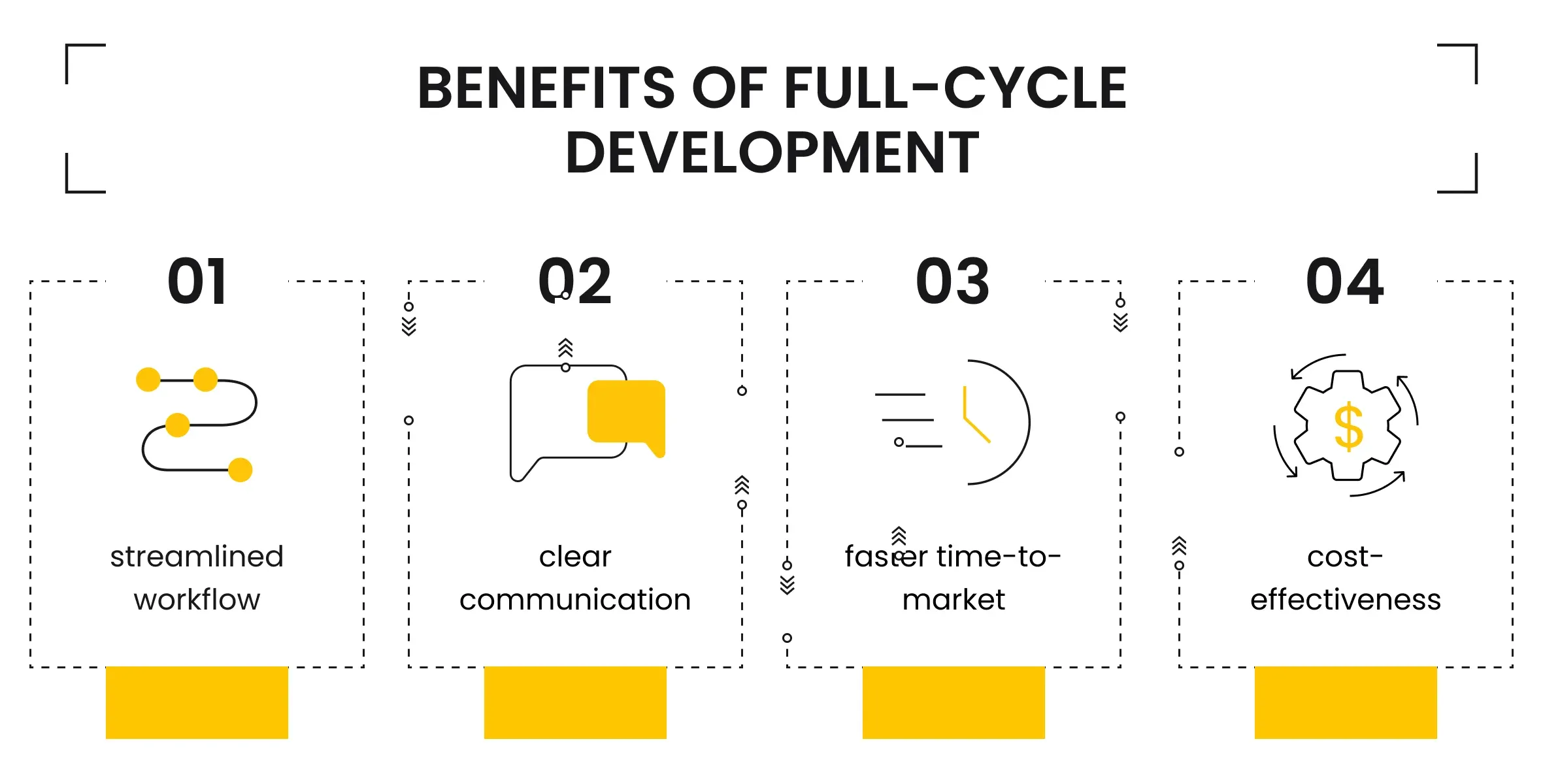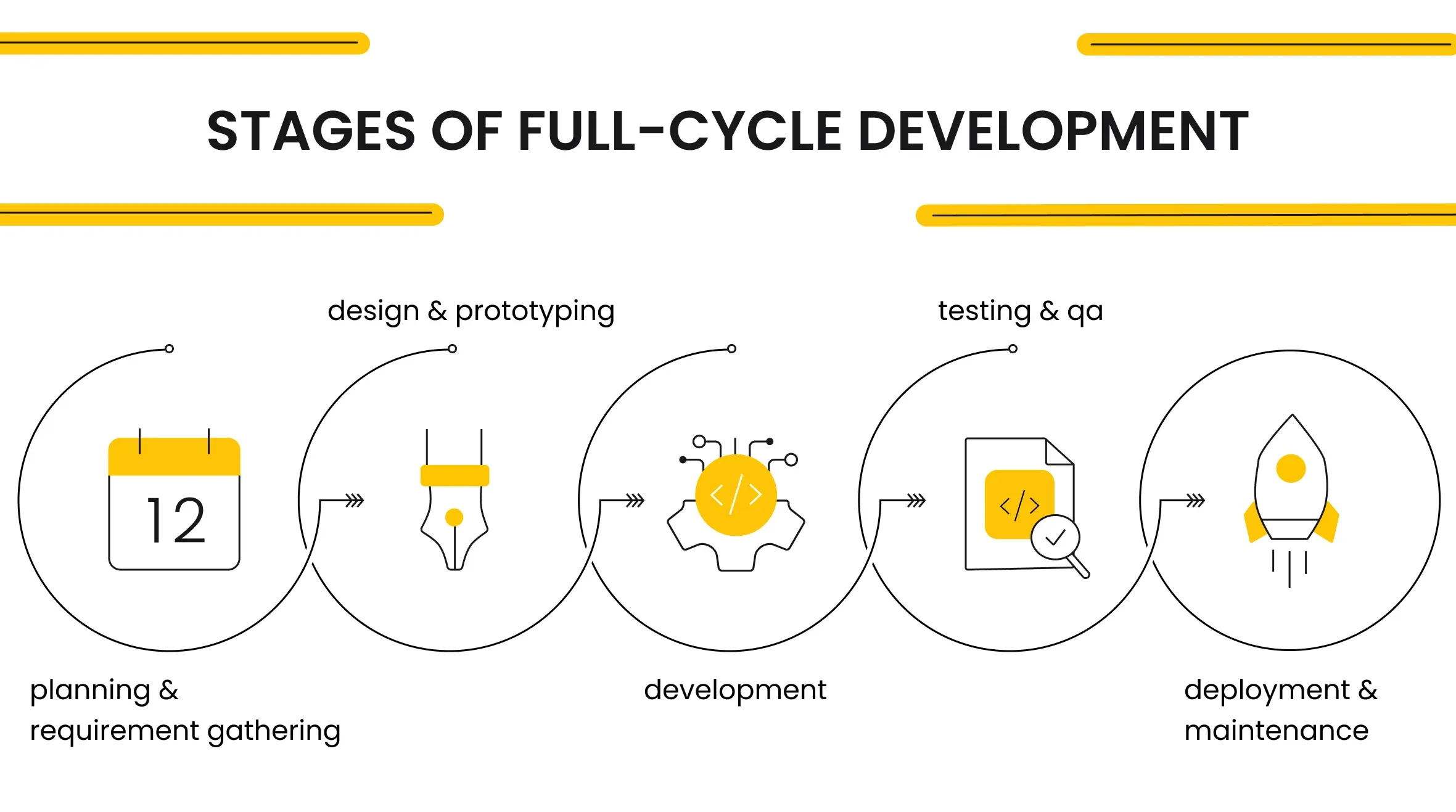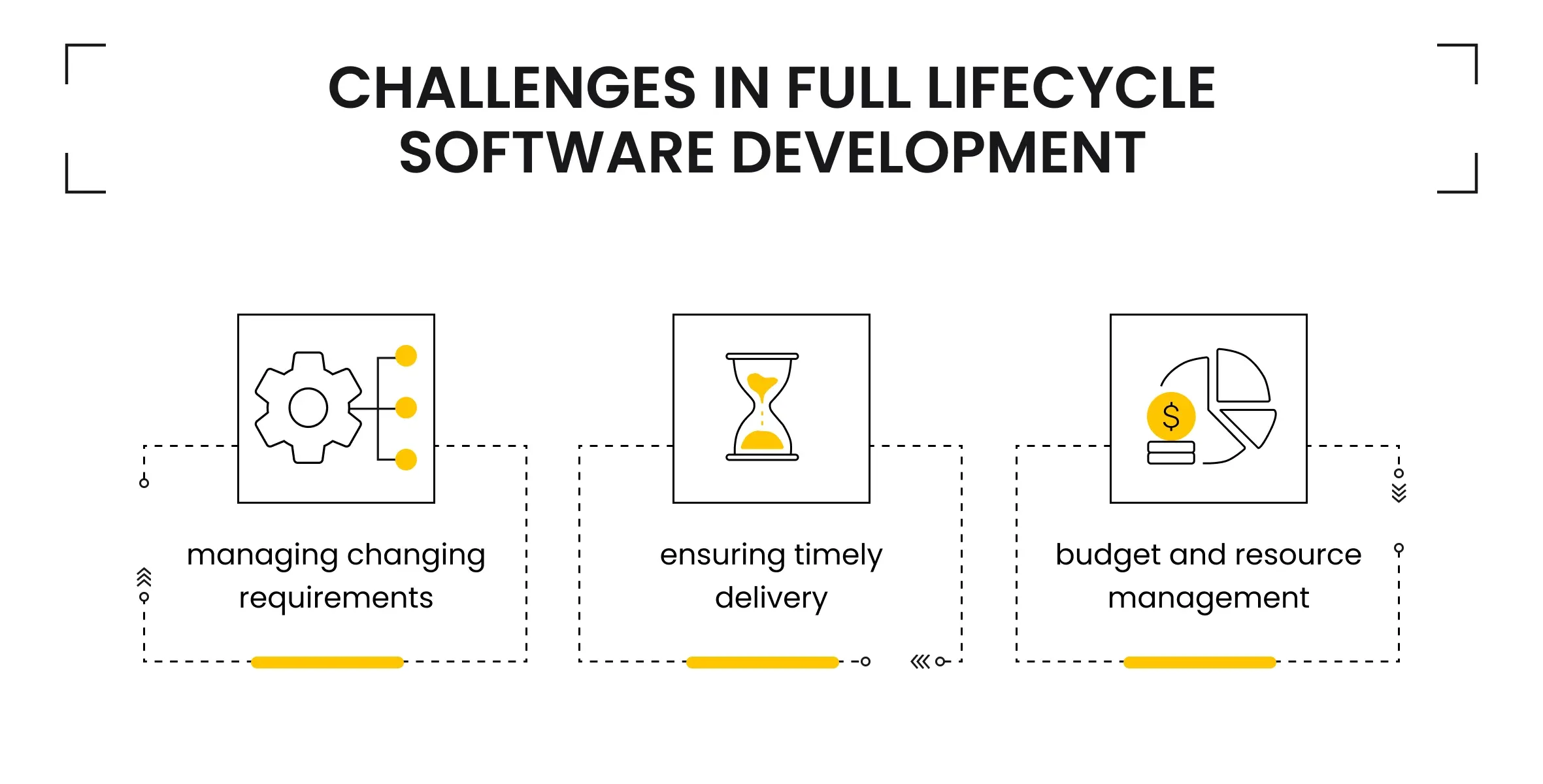Full-Cycle Software Development – A Complete Guide
June 11, 2024 • 550 Views • 18 min read
Tetiana Stoyko
CTO & Co-Founder
One of the most beneficial software creation approaches is full-cycle software development. Why is it so popular and what are the main benefits of full SDLC?
To answer these questions, we have to define some basics first.
What is Full-Cycle Software Development?
Full-cycle software development services suggest creating software solutions, covering all stages and aspects of the development project.

To simplify it, let’s consider the main differences between the full software development lifecycle and a more usual development approach - IT outsourcing:
- IT outsourcing is common when business owners require short- or mid-term development. For instance, the business is scaling and requires a few extra features, but the in-house team is engaged in other development activities. So, a business owner hires a dedicated development team to perform these tasks.
- Full-cycle software development, on the other hand, is a preferred choice for startups, and projects, that require consistency and accuracy.
To cut a long story short, the full software development lifecycle is a development approach for projects, that covers all processes and stages from start to the very end.
So, when you hire a dedicated development team for full-cycle implementation, you hire till the end of the project and engage them in all stages like planning, prototyping, QA software testing, development, deployment, and maintenance.
These developers are simply an outsourced version of your in-house team, which dedicatedly works until the end of the project.
The in-house development team is also viewed as full-cycle developers. But why should you consider full-cycle custom software development services instead of dividing your project into different sprints?
And what are the benefits outsourced full-cycle developers can offer to your business?
Benefits of Full-Cycle Development

The most basic and obvious benefit of full lifecycle development is its consistency. In other words, it delivers a full-fledged working software product, making the development process more efficient and faster.
Otherwise, by divining your software development into various standalone steps, you:
- Increase the development pipeline: from planning to implementation
- Face more issues with knowledge sharing: full-cycle software development company employees are familiar with the code from the beginning and don’t require as often code reviews, as it is with the separated development teams.
Besides, a full life cycle of software development is an ideal approach for MVP development. Full SDLC makes it possible to plan all steps in advance and gradually implement them.
Also, dedicated full-cycle developers for startups are a great option to set up a working environment and maintain it in more convenient terms for both parties.
Streamlined Workflow and Clear Communication
During full-cycle software development, every team member is aware of the main goals and roles, because everyone is engaged since the planning stage.
This positively impacts the performance of each full-cycle developer: all of them know what is the next step or task. First of all, it helps to speed up the software development lifecycle by avoiding the need for agreeing next steps.
Besides, full-cycle developers are aware of the next tasks and potential issues they will face, so they plan scalable and flexible coding. So, the next development stages were easier to implement and combine with the existing code blocks.
Finally, when each full-cycle developer is familiar with the responsibilities of other team members, they can create more clear and efficient communication: you know whom to contact in certain circumstances.
Faster Time-to-Market
Full-cycle software development services foresee no interruptions during the development cycle. At least, if it is possible.
To simplify it, after the discovery phase of your project, the full life cycle of software development has defined deadlines, stages, and tasks.
Full life cycle implementation can be compared with a train on the rails: there is a straight line ahead and no limitations or obstacles.
Therefore, such a development approach offers faster time-to-market implementation. Some issues can appear on the way, yet they will most likely be insufficient to stop the development cycle.
Cost-Effectiveness
The consistency of full-cycle software development services also results in better budget management. It appears to be cost-effective in numerous ways.
First of all, thanks to detailed planning during the discovery phase, new unpredicted expenses will unlikely appear.
Additionally, planning and starting the whole development cycle at once helps to avoid expense uncertainty: it is easier to avoid inflation, or calculate the differences between the costs for custom software development from various teams and regions, etc.
Finally, full-cycle development assumes cooperation with the same team of developers. So, you can plan and predict potential salary reviews, bonuses, etc.
To make your full-cycle development even more cost-efficient, you can combine it with the advantages of IT outsourcing to Ukraine, by hiring niche-experienced developers for even less costs.
So, you will have an experienced team on board, with a predicted budget and clear expectations.
Stages of Full-Cycle Software Development

So, how to implement a full software development lifecycle? What does it look like, and what are the core stages of such a software development approach?
1.Planning and Requirement Gathering
Just like any other software product development, full life cycle implementation always starts with planning and requirement gathering.
The planning stage and project estimation are crucial for success and efficiency in any software development. However, to ensure that your full SDLC will be a success, you must pay attention to even the smallest detail.
While other development approaches are more flexible in process, allowing to change the objectives and goals on the go, full lifecycle development is more monolith.
Of course, it can, and will be changed during the work. Still, it is also more vulnerable to rapid changes.
So, don’t rush yourself, and take the time you need to make a thoughtful and accurate calculation and estimation of all your needs. For instance, among the core aspects to take into account during your full-cycle implementation planning stage are:
- The core features of an app: the best way is to start with an MVP so that you can speed up the process of app publication. Therefore, you can start finding your target audience, tracking the efficiency of development, and analyzing feedback for further implementations and improvements.
- Main goals and metrics: it is important to define very precise and accurate goals, you want to achieve in the end. “A successful application” is great, but how exactly to define its success? Create a list of KPI for software development or other metrics, which will be more accurate and help understand the progress. For instance, instead of “efficient app” choose an “app with performance results over 70%”.
- Tech stack: having clear expectations of your goals, you should choose technologies, which will be the most suited to accomplish your expectations and deliver the required features. At this moment, you should discuss the technologies with your development team. Full-cycle developers are more aware of the pros and cons of certain solutions, so can give informed advice.
- Roadmap: finally, create at least an approximate roadmap with all deadlines and stage estimations. This helps to prioritize tasks during full-cycle development and keep track of the progress. Frankly, each development process faces unpredicted circumstances and stays behind schedule. Still, it is better to have one, than not having any idea of the approximate development time.
2.Design and Prototyping
After including the aforementioned, and writing an SRS document, your full-cycle developers can proceed to the first development steps.
To cut a long story short, at this phase, your development team will have to design the potential project, visualize the final concept, create a prototype, and test it.
Most likely, it won’t be a working application, but rather a combination of various elements and components, so that you can see how it might look like. This stage is needed to make final adjustments and figure out, whether your ideas can be embodied as supposed to.
Having a prototype design at hand, you can better understand what it lacks, or what else it might need. To sum up, at this stage, you can compare the “appearance” and “concept” and align them with each other.
3.Development
After the final preparations, you can start the full-cycle software development.
At this moment, you, as a business owner or project manager, should clarify all the responsibilities of each full-cycle developer, and define the set of the working environment:
- Main communication tools and methods
- Working routine
- Standup and meetings schedule
- Access to project documentation
- Credentials and access to various elements, etc
All the rest is the responsibility of the full-cycle software development company and its team. All you can and should do - is monitor the progress, resolve issues, or make decisions if needed.
4.Testing and Quality Assurance
One of the best software testing and quality assurance practices - is to start them simultaneously with the development.
So that your testing team can identify issues or problems as well as they appear. Alternatively, you can start software testing, when at least the core features are embodied.
Still, the best way to choose the right approach - is to discuss it with your full-cycle software development team. They are the ones, who can give you rational and more suited advice, depending on the project context.
5.Deployment and Maintenance
One of the most significant advantages of full lifecycle development can be spotted after the development ends.
To cut a long story short, your dedicated full-cycle developers are familiar with the project: they were engaged from the very beginning. All full-cycle software development services also include post-development aspects like deployment and maintenance.
In other words, apart from developing an app, the same team is engaged in fixing and optimizing it. First of all, this guarantees higher product quality, because it is their direct responsibility to deliver the expected results.
Additionally, having engaged developers on board, familiar with the whole code makes it easier to navigate through it, and define the potential issues.
So, full-cycle development also offers faster and more efficient application deployment, optimization, and maintenance.
Challenges in Full Lifecycle Software Development

Despite the obvious and crucial benefits of full-cycle software development services, they also have some challenges to deal with.
Managing Changing Requirements
As was mentioned before, the full life cycle of software development depends on planning and is more vulnerable to unpredicted changes during the development process.
It doesn’t mean, that you can’t change anything, what was preplanned. However, it might be a tangible challenge to implement them, so that they won’t impact the rest processes.
So, when choosing full-cycle development, get prepared to make difficult decisions on how to implement changes avoiding the need to restructure and redesign the whole project.
Ensuring Timely Delivery
Once again, issues and challenges occur during any software development. This also slows down the full-cycle development.
Having a roadmap and precise plan with deadlines for each process is a benefit. However, no one can guarantee, that everything aligns with the plan.
Therefore, you have to pay a lot of attention and effort to ensure, that delays are not as sufficient, and full-cycle developers keep up with time as much as possible.
Budget and Resource Management
Eventually, let’s talk about money and other resources.
Each business owner, who dealt with software development knows: “It's always not enough!” While planning and estimating your future app, everything seems seamless and almost perfect.
Nevertheless, when it comes to full-cycle software development, new ideas and suggestions appear here and there. Issues and other challenges do the same.
So, sometimes it can seem to be a micromanagement hell, which requires full engagement of you and the team to balance everything.
Fortunately, there is a way to deal with all these challenges and improve your life as much as possible. The secret is simple: find a trustworthy full-cycle software development company like Incora.
To prove our point, we present you our case studies so that you can take a look at our working principles and tasks, we are experienced in.
We encourage you also to discuss your idea so that we all can find the best way to deliver your ideas as stressless and efficiently, as possible.
What’s your impression after reading this?
Love it!
1
Valuable
1
Exciting
1
Unsatisfied
1
FAQ
Let us address your doubts and clarify key points from the article for better understanding.
What is the full cycle developer model?
The full cycle developer model refers to a software development approach where developers are responsible for the entire lifecycle of a software product. This encompasses everything from initial planning and design through development, testing, deployment, and maintenance. The goal is to streamline the development process, improve quality, and foster a sense of ownership and accountability among developers.
How many steps are in the development cycle?
The development cycle can be broken down into several steps, although the exact number and categorization may vary depending on the methodology and framework used (e.g., Agile, Waterfall, DevOps). However, a typical full cycle development model includes the following six steps:
- Planning and Design
- Development
- Testing
- Deployment
- Maintenance
- Documentation
What is SDLC?
The Software Development Life Cycle (SDLC) is a systematic process for planning, creating, testing, and deploying information systems. The SDLC aims to produce high-quality software that meets or exceeds customer expectations, reaches completion within times and cost estimates, and is easy to maintain and enhance. The SDLC process typically includes several distinct phases, each with specific activities and deliverables.
Key Phases of the SDLC:
- Planning
- Requirements Analysis
- System Design
- Development
- Testing
- Deployment
- Maintenance
you may also like
Let’s talk!
This site uses cookies to improve your user experience. Read our Privacy Policy
Accept

Share this article